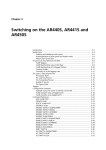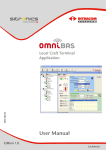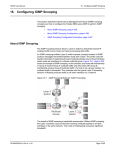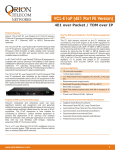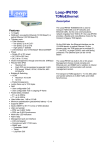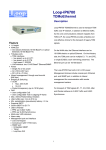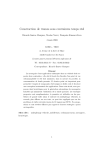Download PW Status Signaling and BFD over VCCV
Transcript
TMOS MPLS Application Manual 11. MPLS Pseudowires 11. MPLS Pseudowires Return to Main Page The Tellabs 8800 TMOS software supports the configuration and monitoring of pseudowires (PW) in a MPLS-enabled Packet Switched Network (PSN). The following sections provide background and describe procedures for configuring PWs: • About Pseudowires, page 36-143 • PW Status Signaling, page 36-145 • BFD over VCCV for PWE3, page 36-150 • Configuring Static Multi-Segment Pseudowire, page 36-158 About Pseudowires Pseudowires Pseudowire-Emulation-Edge-to-Edge (PWE3) is a mechanism that emulates a telecommunications service, for example, ATM or Frame Relay, over a variety of PSN types. A PWE3 circuit allows traffic originating from customer edge (CE) to traverse the PSN while maintaining characteristics of a native service. From the perspective of the customer edge (CE) device, the PW is characterized as an unshared link or circuit of the chosen service. A PW is set up between two provider edge (PE) nodes in an MPLS network. The PE then connects to the CE through an attachment circuit (AC). Figure 11.1, page 36-143 shows the PWE3 Reference Model with two Tellabs 8800 series MSRs acting PE nodes. Figure 11.1 PWE3 Reference Model The Tellabs 8800 Series MSR architecture applies MPLS Label Distribution Protocol (LDP) and Resource Reservation Protocol (RSVP) to set up and maintain pseudowires across a network. A PWE3 circuit consists of two unidirectional flows, shown as PW1 and PW2, in Figure 11.1, page 36-143. Both sides of the PW must be configured for the PWE3 circuit to be operational. For example, both PE Nodes A and B in Figure 11.1, page 36-143, must be configured for two PWs, A to B and B to A, for the PWE3 circuit to be operational. 76.880080/36, Rev A, 7/09 Page 36-143 11. MPLS Pseudowires TMOS MPLS Application Manual Other sections of the Tellabs 8800 TMOS and Tellabs 8890 user manuals refer to PWE3-based circuits as martini circuits or remote circuits. This section uses the terms, PW and PWE3, to refer to this type of virtual circuit path. Refer to Key PW Terms, page 36-144, for terminology used in this section. Key PW Terms The following are PWE3 terms and definitions: • Attachment Circuit (AC)—The physical or virtual circuit attaching a CE to a PE. An AC can be an ATM VPI/VCI, an Ethernet port, a VLAN, or other native service. • Customer Edge (CE)—A device where a service originates and terminates. In the case of PWE3, the CE is not aware that it is using an emulated service rather than a native service. • Packet Switched Network (PSN)—A network that uses IP or MPLS for packet forwarding. • Provider Edge (PE)—A device that provides PWE3 to a CE. Also referred to as a node, or PE node. • Pseudowire (PW)—A connection between two PEs. Each PE terminates an AC. The PW is a path for an emulated circuit originating from the AC to traverse the PSN. • PSN Tunnel—A tunnel across a PSN on which PWs are carried. The Life of a Pseudowire The following sections describe a generalized PW setup and maintenance: • Setting Up an LDP Session, page 36-144 • Setting Up the Pseudowire, page 36-144 • Tearing Down a PW, page 36-144 Figure 11.2, page 36-145, outlines a lifetime scenario for a PWE3 circuit. Setting Up an LDP Session Two Tellabs 8800 Series MSRs, PE nodes A and B, set up an LDP session using an extended discovery mechanism. Extended discovery supports LDP sessions between PE nodes that are not directly connected with targeted hello messages to specific addresses. This establishes the nodes A and B as pseudowire endpoints. Setting Up the Pseudowire The nodes exchange LDP Label Mapping messages to set up the pseudowire. The PW exchanges labels when the following three conditions are met: • An LDP session is established between peer nodes. • The pseudowire circuit is administratively enabled. • The peer addresses are known to the LDP session. The PW is considered operationally up when free of AC and local forwarding errors, and when the labels have been successfully exchanged. Tearing Down a PW Page 36-144 In the case where a pseudowire is no longer needed, a PE node initiates a PW teardown by sending an LDP label withdraw message. All labels associated with the pseudowire are removed. 76.880080/36, Rev A, 7/09 TMOS MPLS Application Manual 11. MPLS Pseudowires Figure 11.2 PW Lifetime Scenario PW Status Signaling The Tellabs 8800 Series MSR supports PW status signaling, a capability of PWE3s and the LDP control plane. PW status signaling generates fewer LDP FEC messages than label withdraw, lessening the impact of CPE faults on the network. The following sections describe the implementation of pseudowire (PW) status signaling as part of an MPLS-enabled network: • About Pseudowire Status Signaling, page 36-145 • PW Signaling Functionality, page 36-148 • PW Status Signaling and the Life of a Pseudowire, page 36-146 • PW Signaling Functionality, page 36-148 • Configuring PW Status Signaling, page 36-149 About Pseudowire Status Signaling PW status signaling allows a PE node to notify its remote PE peer when AC errors or local forwarding errors occur. When PW status signaling is enabled, the PE node uses the LDP notification messages to signal error conditions. The LDP notification message contains the PW Status TLV (type-length-value tuple). PW status signaling uses the PW Status TLV to convey PW status if any AC-side or local forwarding errors are detected. Alternatively, label withdraw can be used for to signal a change in status. With label withdraw, the PE node withdraws the label for the PW to signal a status change. When the errors are cleared, the PE then rebuilds the PW, and re-advertises the labels. This generates LDP FEC messages and increases the processing load on a network. 76.880080/36, Rev A, 7/09 Page 36-145 11. MPLS Pseudowires TMOS MPLS Application Manual Because PW status signaling generates fewer LDP FEC messages than label withdraw, PW status signaling reduces the processing load in initiating, terminating, and transit nodes. In addition, PW status signaling enables quicker PW setup because the initiating PE node does not wait for the ACs to become active before establishing the PW. PW Status Signaling and the Life of a Pseudowire The following sections describe a generalized a PW setup and maintenance with PW status signaling enabled: • Setting up an LDP Session, page 36-146 • Negotiating PW Status Signaling and Setting Up the Pseudowire, page 36-146 • Detecting PW Status, page 36-146 • Tearing Down a PW, page 36-146 Figure 11.3, page 36-147, outlines a lifetime scenario for a pseudowire with PW status signaling. Setting up an LDP Session Two Tellabs 8800 series MSRs, PE nodes A and B, set up an LDP session using an extended discovery mechanism. Extended discovery supports LDP sessions between PE nodes that are not directly connected with targeted hello messages to specific addresses. This establishes the nodes A and B as pseudowire endpoints. Negotiating PW Status Signaling and Setting Up the Pseudowire The nodes exchange LDP Label Mapping messages to set up the pseudowire. With PW status signaling enabled, the nodes exchange Label Mapping messages regardless of the AC state or LSP availability. The LDP Label Mapping message includes the PW status code which is used during the lifetime of the pseudowire. The PW exchanges labels when the following three conditions are met: • An LDP session is established between peer nodes. • The pseudowire circuit is administratively enabled. • The peer addresses are known to the LDP session. With PW status signaling enabled, the PE nodes attempt to establish the PW even if the AC is operationally down or if there is a local forwarding error. Refer to Setting Up the Pseudowire, page 36-144, for a PW setup with PW status signaling disabled. Detecting PW Status During the lifetime of a PW, PW status signaling uses the PW status code to signal AC errors and local forwarding errors. Refer to PW Status Signaling Error Faults Conditions, page 36-147, for details on the PW status code. Tearing Down a PW In the case where a pseudowire is no longer needed, a PE node initiates a PW teardown by sending an LDP label withdraw message. All labels associated with the pseudowire are removed. With PW status signaling enabled, the PW label is withdrawn only when one or more of the following conditions occur: Page 36-146 • The pseudowire configuration is deleted. • The operator disables the pseudowire. 76.880080/36, Rev A, 7/09 TMOS MPLS Application Manual 11. MPLS Pseudowires • Figure 11.3 PW Status Signaling Error Faults Conditions LDP session down or LDP address down errors occur. PW Lifetime Scenario with PW Status Signaling Enabled Table 11.1, page 36-147, lists PW fault descriptions based on pseudowire type, error conditions, and the network side where the fault is detected. Table 11.1 Error Conditions Carried in the PW Status TLV PW Type Error Condition Side PW Fault Description Any PW BFD session down LSP PW not forwarding PWE3 circuit Interface down Circuit AcRxFailure—Attachment circuit (AC) receive failure AcTxFailure—AC transmit failure PWE3 redundant bundle member Circuit bundle disabled Circuit AcRxFailure—AC receive failure AcTxFailure—AC transmit failure PWE3 redundant bundle member Circuit bundle down Circuit AcRxFailure—AC receive failure AcTxFailure—AC transmit failure VPLS PW Bridging instance down Circuit AcRxFailure—AC receive failure AcTxFailure—AC transmit failure Mirroring target PW Target or mirroring instance not enabled Circuit AcRxFailure—AC receive failure AcTxFailure—AC transmit failure Any LSP not found LSP PsnRxFailure—Packet switched network (PSN) receive failure PsnTxFailure—PSN transmit failure Any LDP address down LSP No PW status code; label is withdrawn. 76.880080/36, Rev A, 7/09 Page 36-147 11. MPLS Pseudowires TMOS MPLS Application Manual Table 11.1 Error Conditions Carried in the PW Status TLV (Continued) PW Type Error Condition Side PW Fault Description Any Circuit is administratively disabled N/A No PW status code; label is withdrawn. Any Circuit configuration delete N/A No PW status code; label is withdrawn. If the pseudowire circuit is administratively disabled, or the circuit configuration is deleted, PW status signaling is not applied and the associated label is withdrawn instead. PW Signaling Functionality PW status signaling functions on a Tellabs 8800 series MSR with the following conditions: • For PW status signaling to be active, both PE nodes on a PWE3 circuit must support PW status signaling. Although you can configure and enable PW status signaling on one PE node, notification messages are not sent until both ends are configured and enabled. • If either PE node does not include the PW status in the label mapping message, then both PE routers revert to LDP Label Withdraw messages to signal status. • The use of group and wildcard notification messages is supported. This minimizes the number of messages sent when a status change affects multiple pseudowires. - The PW ID field in all LDP PW messages contains a group ID as well as a specific PW ID. When a message omits a specific PW ID, the message then applies to all PWs in the group. - The Tellabs 8800 series MSR uses the same group ID for all PWE3 circuits using the same port-side Layer 2 interface. • Only single-segment PWs, not multi-segment PWs, can apply PW status signaling. • If you upgrade an existing network that does not support PW status signaling, PW status signaling remains disabled by default in the upgraded network. After upgrading a node and enabling PW status signaling, circuits created after the upgrade will use PW status signaling. However, circuits created prior to the upgrade will not use PW status signaling until after the node is restarted. • PW status signaling is supported for all PWE3 types. The Tellabs 8800 series MSRs report PW status change for any of the following conditions: Page 36-148 • The ULC is operationally down. • The PLM is operationally down. • The port is operationally down or administratively disabled. • The LAG, APS or multilink group is operationally down. 76.880080/36, Rev A, 7/09 TMOS MPLS Application Manual 11. MPLS Pseudowires • The interface is operationally down or administratively disabled. • An SFP transmit or receive optic fault occurs. • Local SONET faults like LOS, LOF, AIS, and NBET, for example, are detected. • Receive remote SONET faults like RDI, AIS, FBET, for example, are detected. • AIS and RDI receive ATM OAM fault indications are detected. Configuring PW Status Signaling Enabling PW Status Signaling By default, PW status signaling is disabled. Enable PW status signaling globally on a node, as described in Table 11.2, page 36-149. Table 11.2 Enable PW Status Signaling Command Entry Purpose Step 1. 8800# enable config protocol mpls ldp Enter LDP configuration mode. Step 2. 8800(cfg-mp-ldp)# pw-status-signaling enable Administratively enable PW status signaling on a node. Step 3. 8800(cfg-mp-ldp)# exit all Exit LDP configuration mode. Step 4. 8800# show protocol mpls ldp Display LDP configuration mode to verify PW status signaling state. Viewing PW Signaling and PW/AC Fault Status The CLI show commands in this section display the status of the PW configuration, and the status of the PW. Use the show protocol mpls ldp command to display the global PW status signaling configuration information. 8800# show protocol mpls ldp LDP Default Parameters: Advertisement Mode: unsolicited; Label Retention Mode: liberal Hello Timer: 15(sec); Targeted Hello Timer: 45(sec) …. …. Label filter - Host only: True; Loopback only: True Target Response Mode: enable; QoS Mode: Disabled Pw status signaling: Enable Use the show ckt <ckt name> detail or extensive commands to display the PW status related information related to the circuit. 8800# show ckt name v1 detail circuit: v1; type: vlan ... side1: port; in status: up; out status: up int: ge-1/1/4/1; type: vlan; id: 22; pri: ignore Signal XC Alarm: disabled; side2: lsp; in status: Peer not forwarding; out status: Peer not forwarding dynamic out-lsp: test (Learnt); out vc-label: 1031, in vc-label:1036 service-type: ethernet; group-id: 3053453313; vc-id: 1031 Pw Status Signaling In Use: Enabled; Sent: Enabled; Remote: Enabled PW Status Failure Local: notForwarding, acTxFailure PW Status Failure Remote: acTxFailure, psnRxFailure Use the show ckt pw-status enable command to display the circuits with PW status signaling in use. 76.880080/36, Rev A, 7/09 Page 36-149 11. MPLS Pseudowires TMOS MPLS Application Manual 8800# show ckt pw-status enable Circuit Name Type Ad Op out-vclabel*/vcid ----------------- -- -- ----------------vlan1 vlan en dn 1010 vlan42 vlan en up 1023 Total Up: 1; Total Down: 1; Total: 2 BFD over VCCV for PWE3 Bidirectional Forwarding Detection (BFD) over Virtual Circuit Connectivity Verification (VCCV) is a pseudowire (PW) fault detection mechanism. BFD over VCCV is an Operations and Maintenance (OAM) failure detection method applied in an MPLS network to validate the data plane and verify PW connectivity. In an MPLS network carrying traffic over PWE3s, it is important to quickly detect PW failures to minimize impact to customer traffic. The Tellabs 8800 series MSR also supports an operator-initiated LSP ping as a diagnostic tool to detect PWE3 circuit failures. For details about LSP ping, refer to Basic Ping and Traceroute Operations, page 36-86. BFD over VCCV offers the following advantages over LSP ping when detecting PW faults: • Faster detection time • Monitors a greater number of PWs The implementation of both BFD over VCCV and LSP ping in the Tellabs 8800 series MSR provides validation and consistency of data and control planes. The following topics are available to help configure BFD over VCCV for PWE3 service: • About BFD over VCCV for PWE3, page 36-150 • BFD over VCCV Functionality on the Tellabs 8800 Series MSR, page 36-152 • BFD over VCCV Configuration Guidelines, page 36-153 • Configuring BFD over VCCV, page 36-153 About BFD over VCCV for PWE3 BFD over VCCV uses the BFD protocol as a connectivity verification type over a VCCV control channel to monitor PW connectivity and quickly detect faults. The PW uses the Pseudowire Emulation Edge to Edge (PWE3) mechanism to carry customer traffic across a PSN. Refer to About Pseudowires, page 36-143, for an explanation of the terms used in this section. This section provides background information about the protocols used when implementing BFD over VCCV in the following sections: Page 36-150 • About BFD, page 36-151 • About VCCV, page 36-151 • BFD over VCCV, page 36-151 76.880080/36, Rev A, 7/09 TMOS MPLS Application Manual About BFD 11. MPLS Pseudowires BFD is a generic, low-overhead, short-duration failure detection protocol. It provides failure detection on any kind of path between systems, including physical links, virtual circuits, tunnels, MPLS LSPs, multihop routed paths, and unidirectional links. When applied to PWs, BFD provides fault detection through the continuous monitoring of the PW data path. For additional BFD capabilities not covered in this section, refer to the Tellabs 8800 TMOS User Manual, 76.880080/4. About VCCV Virtual Circuit Connectivity Verification (VCCV) is a control plane protocol for pseudowires to aid in end-to-end fault detection and diagnostics. VCCV provides a control channel between the ingress and egress points of a pseudowire, in this case the PE nodes, over which verification messages are sent. This functionality permits verification of PW connectivity and the data plane used to transport the data path for the PW. For details about VCCV, refer to About VCCV, page 36-88. BFD over VCCV With the BFD over VCCV protocol, the VCCV CC and CV types (refer to VCCV CC Type, page 36-88, and VCCV CV Types, page 36-89, for details) are negotiated when the PW is established. The PE can then initiate a BFD session when the following conditions are met: • The BFD protocol is administratively enabled on a PW. • Both CC and CV capabilities between local and peer PEs are matched. • The PW is operationally up. The BFD session will be operationally up only when both sides have BFD administratively enabled on a PW. Figure 11.4, page 36-151, shows a VCCV control channel carrying BFD control messages that monitor a PW. Figure 11.4 76.880080/36, Rev A, 7/09 BFD over VCCV Monitoring a PW on an MPLS Network Page 36-151 11. MPLS Pseudowires TMOS MPLS Application Manual The PE node maintains the BFD session by periodically transmitting control packets after successful establishment of a session. If packets are not received by a PE within the negotiated time interval, the session to that PE is declared to be operationally down. The PE assumes the pseudowire has failed, and takes appropriate action. Other PE node functions, like alarm reporting and PW status signaling, are notified about the failure detected through BFD over VCCV. If PW status signaling is enabled, the PE node signals the status to the PE peer. BFD over VCCV Functionality on the Tellabs 8800 Series MSR The following topics describe how BFD over VCCV operates on the Tellabs 8800 series MSR: BFD over VCCV Characteristics • BFD over VCCV Characteristics, page 36-152 • PW Down Status Notification, page 36-153 • Applying BFD over VCCV on Existing PWs, page 36-153 The Tellabs 8800 series MSR implementation of BFD over VCCV is as follows: • The PW is declared down when BFD control packets are not received within a configured interval. • BFD over VCCV operates only in asynchronous mode. In asynchronous mode, a pair of systems periodically sends BFD control packets to each other. If a number of packets in a row is not received by the other, the session is declared to be down. • Echo function is not available for BFD over VCCV. • The Tellabs 8800 series MSR takes an active role as a PW endpoint. BFD session comes up after the PW is operationally up, and after BFD is administratively enabled on both sides of the PW. • Support for CC type, TTL Expiry. • Support for CV types BFD IP/UDP Fault Detection and LSP Ping. • The following BFD session parameters are configurable: - Enable/Disable the BFD session - Desired minimum transmit interval - Detection multiplier - Required minimum receive interval - BFD session established wait time Refer to Configuring BFD over VCCV, page 36-153, for configuration procedures. Page 36-152 • Changes to BFD session parameters at any time during the BFD session are permitted, without the need to first disable the BFD session on the PW. • Support for single-segment PWs only, as the BFD over VCCV protocol does not support multi-segment PWs. • Support for dynamic PW circuits. 76.880080/36, Rev A, 7/09 TMOS MPLS Application Manual 11. MPLS Pseudowires • PW Down Status Notification Applying BFD over VCCV on Existing PWs BFD over VCCV support for the following PW types: - ATM - Ethernet - VLAN, including Q-in-Q - SAToP When the BFD session detects that the PW is down, the Tellabs 8800 series MSR signals fault status and takes the following actions: • If the PW is part of a redundant bundle, the PE switches to another member of the bundle. • If PW status signaling is enabled, the PE sends the status to the peer PE. • If PW status signaling is not enabled, the PE withdraws the labels. • The PE uses an SNMP trap to report the change in status of the PW. The Tellabs 8800 series MSR permits the application of BFD over VCCV to existing PWs. To add BFD over VCCV to a set of endpoints where PW was established in FP7.3 or earlier, and now upgraded FP8.0, the PW must be torn down and re-established through the exchange of LDP Label Mapping messages. An exchange of Label Mapping messages occurs with one of the following actions: • If the system restarts, or if MPLS undergoes a graceful restart. • Change of PW operational status (disable PW status signaling). BFD over VCCV Configuration Guidelines Apply the following guidelines when configuring BFD over VCCV on a pseudowire: • Configure BFD over VCCV only on ATM, Ethernet, VLAN (including Q-in-Q), or SAToP PWE3 circuits. • The PE peer must also support CC type, TTL Expiry and CV type, BFD IP/UDP Fault Detection. • Adhere to scaling of up to 100 BFD sessions with a one (1) second transmit/receive interval and a detect multiplier of five (5). Configuring BFD over VCCV Use the following TMOS commands to configure a BFD session on a PW. Configure both ends of the PW to enable the BFD session. Refer to the Tellabs 8800 TMOS Command Reference Manual, 76.880080/5, and the Tellabs 8800 TMOS Operations Reference Manual, 76.880080/6, for details, including default values and available ranges. Enabling or Disabling BFD on a PW Endpoint 76.880080/36, Rev A, 7/09 Table 11.3, page 36-154 lists configuration commands to enable BFD on the LSP side of a dynamic circuit. Page 36-153 11. MPLS Pseudowires TMOS MPLS Application Manual Note: This procedure assumes that side id 1 of the circuit is already configured. Refer to the Tellabs 8800 TMOS User Manual, 76.880080/4, for details about configuring this side of the circuit. Table 11.3 BFD Minimum Configuration Command Entry Purpose Step 1. 8800# enable config Enter the configuration mode. Step 2. 8800(config)# ckt name ckt12 side id 2 lsp dynamic-ckt bfd admin enable Enable BFD over VCCV for the LSP side of a dynamic circuit. Step 3. 8800(cfg-ckt-side-bfd [ckt12:2])# exit all Exit the circuit configuration mode. Step 4. 8800# show ckt name ckt12 detail Display BFD configuration parameters for a dynamic circuit to verify administrative state. Setting the Minimum Transmit Interval of a PW Endpoint Table 11.4, page 36-154 lists configuration commands to set the desired minimum BFD packet transmitting interval, in milliseconds, on the LSP side of a dynamic circuit. Note: This procedure assumes that side id 1 of the circuit is already configured. Refer to the Tellabs 8800 TMOS User Manual, 76.880080/4, for details about configuring this side of the circuit. Table 11.4 BFD over VCCV Packet Desired Minimum Transmission Interval Configuration Command Entry Step 1. 8800# enable config ckt name ckt12 Purpose side id 2 Enter the LSP side of the dynamic circuit configuration mode. Step 2. 8800(cfg-ckt-side [ckt12:2])# side id 2 lsp dynamic-ckt bfd desired-min-tx-interval 100 Set the desired minimum BFD packet transmitting interval in milliseconds. Step 3. 8800(cfg-ckt-side [ckt12:2])# exit all Exit the circuit configuration mode. Step 4. 8800# show ckt name ckt12 detail Display BFD configuration parameters for a dynamic circuit to verify minimum BFD packet transmission interval. Setting the Detection Time Multiplier of a PW Endpoint Table 11.5, page 36-155 lists configuration commands to set the BFD detection time multiplier on the LSP side of a dynamic circuit. Note: Page 36-154 This procedure assumes that side id 1 of the circuit is already configured. Refer to the Tellabs 8800 TMOS User Manual, 76.880080/4, for details about configuring this side of the circuit. 76.880080/36, Rev A, 7/09 TMOS MPLS Application Manual 11. MPLS Pseudowires Table 11.5 BFD over VCCV Detection Time Multiplier Configuration Command Entry Purpose Step 1. 8800# enable config enable config ckt name ckt12 side id 2 Enter the LSP side of the dynamic circuit configuration mode. Step 2. 8800(cfg-ckt-side [ckt12:2]# lsp dynamic-ckt bfd detect-multiplier 5 Set the BFD detection time multiplier. Step 3. 8800(cfg-ckt-side [ckt12:2])# exit all Exit the circuit configuration mode. Step 4. 8800# show ckt name ckt12 detail Display BFD configuration parameters for a dynamic circuit to verify detection time multiplier. Setting the Minimum Receive Interval for BFD Control Packets at a PW Endpoint Table 11.6, page 36-155 lists configuration commands to set the required minimum receive interval, in milliseconds, for BFD packets on the LSP side of a dynamic circuit. Note: This procedure assumes that side id 1 of the circuit is already configured. Refer to the Tellabs 8800 TMOS User Manual, 76.880080/4, for details about configuring this side of the circuit. Table 11.6 BFD over VCCV Required Minimum Receive Packet Interval Configuration Command Entry Step 1. Step 2. 8800# enable config enable config ckt name ckt12 side id 2 8800(cfg-ckt-side [ckt12:2]# lsp Purpose Enter the LSP side of the dynamic circuit configuration mode. dynamic-ckt bfd required-min-rx-interval 500 Set the required minimum interval, in milliseconds, between received BFD control packets that the PE is capable of supporting. Step 3. 8800(cfg-ckt-side [ckt12:2])# exit all Exit the circuit configuration mode. Step 4. 8800# show ckt name ckt12 detail Display BFD configuration parameters for a dynamic circuit to verify minimum BFD packet receive interval. Setting the BFD Session Timeout for a PW Endpoint Table 11.7, page 36-155 lists configuration commands to set the BFD session timeout on the LSP side of a dynamic circuit. Note: This procedure assumes that side id 1 of the circuit is already configured. Refer to the Tellabs 8800 TMOS User Manual, 76.880080/4, for details about configuring this side of the circuit. Table 11.7 BFD over VCCV Session Timeout Configuration Command Entry Step 1. 8800# enable config enable config ckt name ckt12 side id 2 76.880080/36, Rev A, 7/09 Purpose Enter the LSP side of the dynamic circuit configuration mode. Page 36-155 11. MPLS Pseudowires TMOS MPLS Application Manual Table 11.7 BFD over VCCV Session Timeout Configuration (Continued) Command Entry Step 2. Purpose 8800(cfg-ckt-side [ckt12:2]# lsp Sets the amount of wait time, in seconds, that an attempt to establish a BFD session to the peer node is made. Once the timer expires, the session is declared down and the clients associated with the session will be notified. dynamic-ckt bfd session-est-wait-timeout 10 The session established wait time can be configured as 0. When set to 0, attempts to establish the session with the peer does not cease and the BFD session status of Down is never sent to client, until such time after successfully establishing the session for the first time. The default value for this parameter is 0. Step 3. 8800(cfg-ckt-side [ckt12:2])# exit all Exit the circuit configuration mode. Step 4. 8800# show ckt name ckt12 detail Display BFD configuration parameters for a dynamic circuit to verify BFD session timeout interval. Viewing PW Signaling and PW/AC Fault Status The CLI show commands in this section display the status of the BFD session-related information. Use the show protocol bfd session command to view all applications and interfaces, including those with BFD over VCCV sessions. 8800# show protocol bfd session Application:Ip(ipv4) Legend: O - OSPF, I - ISIS, B - BGP, S - Static Route Detect Time lcl/rmt Interface Ip Address Client[s] (msec) -------------------------- ----------ge-1/8/1/1.1 2.1.1.2 O 300/300 so-1/8/3/1:1.1 4.1.1.2 O 300/300 Op St -up up Application:Mpls Legend: Pri - RSVP Primary Path, Bkup - RSVP Backup Path, Byp - RSVP Bypass Tunnel, vccv - BFD sessions over vccv. Detect time Lsp Name/ lcl/rmt Ckt Name Fec(to) (msec) Sig -------------------------24atm1 24.24.24.24 5000/5000 VCCV 24eth1 24.24.24.24 5000/5000 VCCV 24vlan1 24.24.24.24 5000/5000 VCCV satop 24.24.24.24 5000/5000 VCCV 37atm1 37.37.37.37 5000/5000 VCCV 24eth2_vbrrt 24.24.24.24 5000/5000 VCCV 37vlan1 37.37.37.37 5000/5000 VCCV 37qinq 37.37.37.37 5000/5000 VCCV elspto37 37.37.37.37/32 5000/300 Pri LDP_24.24.24.24/32l 24.24.24.24/32 5000/300 LDP LDP_24.24.24.24/32o 24.24.24.24/32 5000/300 LDP LDP_24.24.24.24/32p 24.24.24.24/32 5000/300 LDP Total Up: 14; Total Down: 0; St -up up up up up up up up up up up up Op Role ---actv actv actv actv actv actv actv actv actv actv actv actv Total: 14 Use the show protocol bfd session vccv detail or extensive command to display the BFD over VCCV session information for both local and remote PW endpoints. 8800# show protocol bfd session vccv extensive Application: Mpls Circuit Name: 24atm1; Type: VCCV: Circuit Type: atm Circuit Dest Addr: 10.10.1.2; Oper Status: Up; VcId: 1100 Out Lsp Name: LDP_10.10.1.2/32o; Last incoming Intf: none Page 36-156 76.880080/36, Rev A, 7/09 TMOS MPLS Application Manual 11. MPLS Pseudowires Role: active ------Version Remote heard Discriminator Min tx interval(msec) Detect multiplier Min rx interval(msec) Negotiated tx interval Detection time Local ----1 yes 0x14000020 1000 3 1000 1000 3000 Remote -----1 yes 0x10000098 1000 3 1000 1000 3000 Last packet [06/10/2009 18:30:12]: v=1 diag=No diagnostic sta=Up P=0 F=0 C=0 A=0 D=0 R=0 Mult=3 len=24 My=0x10000098 Your=0x14000020 Tx=1000000 Rx=1000000 echoRx=0 Use the show ckt <ckt name> detail or extensive commands to display all BFD configured parameters against the circuit, including the CC and CV values negotiated between the local and peer PEs. 8800# show ckt name vlan1 detail circuit: vlan1; type: vlan Indv Trap: enable; MTU check: disable admin: enable; oper: up; failure reason: none forwarding status: forwarding; side1: port; in status: up; out status: up int: ge-1/1/3/1; type: vlan; id: 1; pri: ignore Signal XC Alarm: disabled; side2: lsp; in status: up; out status: up dynamic out-lsp: LDP_1.1.1.1/32 (Learnt); out vc-label: 1031, in vc-label:1044 group-id: 268500992; vc-id: 1 Pw Status Signaling In Use: disabled; Sending: disabled; Remote: disabled Remote in-use CC: TTL expiry, Local CC: TTL expiry, Local CV: LSP ping, BFD IP/UDP fault det Remote CC: TTL expiry, Remote CV: LSP ping, BFD IP/UDP fault det BFD parameters: Detect mult: 3; Desired min tx interval: 100 msec Required min rx interval: 100 msec; Session establish time: 0 sec Admin: enabled; Oper: up; Failure reason: none Auto optimize mode: disabled; Lsp pref: ip-disable dest: 1.1.1.1; preference: all lsp L2 intf: pos; avg pkt size: 1518 negotiated MTU: local: 1496; remote: 1496 lsp cac bandwidth: 0(Min), 0(Max) L2IfSlotId: 1; Out Label: 1024; Out Intf: ge-1/3/3/4.1; DownStream: 1.1.1.1 Use the show protocol bfd session stats command to display BFD session specific statistics. 8800# show protocol bfd session stats Application: Mpls Circuit Name: vlan50; Discriminator: 0x14000004 Last up: 07/07/2009 10:18:19; Last poll: not available Last down: not available; [No diagnostic] Session up count: 1 Statistics last cleared: not available Control Packet Statistics: -------------------------Sent: 62528 Received: 62530 Use the show protocol bfd global-stats command to display BFD packet statistics. 8800# show protocol bfd global-stats Global Control Packet Statistics: Sent: 2844625 Rcvd: 5571001 Accepted: 2785426 Packet Discard Reason Statistics: Bad Version : 0 76.880080/36, Rev A, 7/09 Page 36-157















